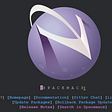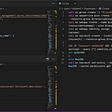An intuitive and visual understanding of number bases.
Numbers are just weird representations of lengths in imaginary (platonic) space. I like to think of numbers as lines that go from a zero outward, and generally it’s easier to think of them as “straight”, or not bendy. So these line are just fine on there own, they can multiply each other, add each other, and all the other arithmetic operations. but for us, storing lines in their true nature is pretty unwieldy. To get around this we developed numbers. numbers are a pretty amazing technology now that I’ve wrapped my head around what they are.
Let’s start with base 10 because most of us are pretty comfortable with that. I’d like for us to imagine a line of squares, standing shoulder to shoulder. the line would start with zero, and there would be 9 1x1 squares, and then 9 10x10 squares and then 9 100x100 squares all standing up fading off into the horizon. (Why there are 9 squares is a bit weird, but the squares are actually distances between points, so there are 10 points and 9 squares.)
So how we use this structure is what makes it so cool. Let’s say we have a line of value 17. it stars at zero, goes past the 1x1 squares, and ends near the end of the first 10x10 square. To turn this into base ten we look with our minds eye and see that it’s bigger than all the 1x1’s, so we check the 10x10’s. 17 takes up almost two 10x10 squares, so it gets a one in that area, but there’s still a bit left over. We take what’s left over down to our cute 1x1’s and see that it’s the length of 7 of those. 17! I’m not sure if this is very exciting for you, but for me this is fabulous.
So now lets hop all the way down to base two. base two looks very different! in base two we have one square of each size. so we have one 1x1 square, then one 2x2 square, then 1 4x4 square, then 1 8x8 square. Now lets take another line that we want to represent in binary, this time of length 5. We start by shopping round for the biggest size square that can take a bite out of 5 and either leave nothing or just a little bit. For example, our 8 square is too big. We instead take the 4x4 square we can peel of 4, and are left with a line of 1. 1 can be easily handled by the first square, so we have the binary representation 101. that said, the two lines (17 and 5) can interact with each other just fine before we turn them into weird symbols!






